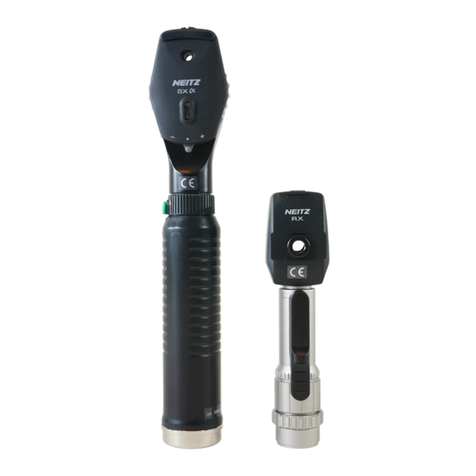
6 / 13
3.2.3 Observation Polarizing Filter
The Observation Polarizing Filter is used when light reflected from the cornea interferes
with examination.
Rotate the disc to insert a polarizing filter into the observation system. When the white
mark on the disc faces up, the Observation Polarizing Filter is aligned perpendicular to the
Polarizing Filter mentioned in 3.2.2, for minimum reflection.
Rotating the disc further will rotate the polarizing axis to allow for a brighter image.Adjust
the disc to obtain the optimum image.
The disc will stop with a click to indicate that the Observation Polarizing Filter has been
disengaged.
3.2.4 Illumination Dial
The Illumination Dial can be used to adjust the illumination entering the patient’s eye as
follows:
Position Aperture/Filter Function
○Normal Aperture Used for typical fundus examinations
Small Aperture Used when examining small pupils. In particular, when
examining through constricted pupils such as during
examination of the macula.
RF Red-Free Filter Red tissue such as blood vessels appear black,
facilitating detection of minute fundal hemorrhages.
Concentric Scale
While observing the patient’s fundus, instruct the
patient to fixate on the center of the concentric scale. It
is possible the determine the presence of eccentric
fixation from the relation between the center of the
concentric scale and the patient’s foveola.
| Slit Using a slit illumination facilitates recognition of
roughness on the surface of the fundus.
3.3 Viewing the Fundus
When observing the fundus, use only illumination with the least intensity
necessary for visualization, and do not
illuminate the patient eye for more than
one minute per eye.
(1) Open theAperture Shutter until it clicks and turn on the
illumination.
(2) To examine the patient’s right eye, hold the
ophthalmoscope in your right hand and observe using
your right eye. To examine the left eye, use your left
hand and eye.
(3) Place your index finger on the edge of the Rekoss Disc
and grip the Handle with the remaining 4 fingers. Use
your index finger to rotate the Rekoss Disc as needed.
(4) Place the upper part of the ophthalmoscope against
the side of your nose and position it so that you have a
clear view when looking through the Viewing Window
(see Fig. 3.2).
(5) While looking at a distant target, rotate the Rekoss
Disc to correct your refractive error.





























